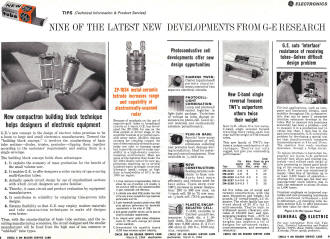Nine of the Latest New Developments from G-E Research |
|
Half a decade after Texas Instruments (Jack Kilby, 1958) and Fairchild Semiconductor (Robert Noyce, 1960) produced the first semiconductor integrated circuits, General Electric must not have been too confident that the newfangled technology was going to take hold. This 2-page spread from a 1964 issue of Electronics magazine, promotes their "Compactron" integrated circuit vacuum tubes. The Compactron is a building block concept where standardized stages of diodes, triodes, pentodes, etc., are encapsulated in a single vacuum tube package with necessary input and output pins for connecting external components. The incentive was smaller volume, lower parts count, lower power supply current, simpler chassis wiring or circuit board layout, and greater ruggedness. One source I found showed the availability in 1962 of 24 distinct Compactron models. Nine of the Latest New Developments from G-E Research
G.E.'s new concept in the design of electron tubes promises to be a boon to large and small electronics manufacturers. Termed the "building block concept," it involves the standardizing of basic tube sections - diodes, triodes, pentodes - clipping them together according to the customers' requirements and sealing them in a single envelope. The building block concept holds these advantages: 1. It exploits the economy of mass production for the benefit of the small volume user. 2. It enables G.E. to offer designers a wider variety of space-saving multi-function tubes. 3. Actually speeds circuit design by use of standardized sections, with which circuit designers are quite familiar. 4. Thereby, it eases circuit and product evaluation by equipment manufacturers. 5. It contributes to reliability by employing time-proven tube designs. 6. Retains flexibility so that G.E. may employ modern materials and tube construction techniques to make old designs even better. Thus, with the standardization of basic tube sections, and the resulting manufacturing economies, the circuit designer and the smaller manufacturer will be freed from the high cost of less common or "odd-ball" tube types.
Posted March 8, 2019 |
|

